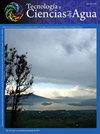基于GIS、PCA和WSA技术的流域水土保持优先排序
IF 0.3
4区 环境科学与生态学
Q4 ENGINEERING, CIVIL
引用次数: 0
摘要
水土保持是干旱和半干旱地区流域的优先事项,以便对水资源进行适当规划和综合管理。这项工作的目标是通过整合地理信息系统(GIS)、主成分分析(PCA)和加权和方法(WSA),确定秘鲁14个地区具有不同地理、水文和地质条件的91个流域的优先次序。此外,采用R和Ward的分层聚类分析方法对均匀区域进行了识别。结果表明,两区高优先级和极优先级的绿化面积占总面积的19.49%。聚类分析结果表明,35%的流域在几何和形状因子上存在均匀带,65%的流域在排水和地形因子上存在均匀带。总的来说,地理信息系统、PCA和SWA方法是一种有效的工具,使决策当局能够更好地规划和保护水文流域的自然资源。本文章由计算机程序翻译,如有差异,请以英文原文为准。
Prioritization of watersheds for soil and water conservation based on GIS, PCA and WSA techniques
Soil and water conservation is a priority in the watersheds of arid and semi-arid regions for the proper planning and integrated management of water resources. The objective of this work is prioritizing 91 watersheds in 14 regions of Peru with different geographical, hydrological and geological conditions, through the integration of Geographic Information Systems (GIS), Principal Component Analysis (PCA) and the Weighted Sum Approach (WSA). In addition, homogeneous regions were identified with hierarchical Cluster Analysis in R and Ward's method. The result showed the existence of 19.49 % of total area in high and very high priority category in two regions. The results of the Cluster Analysis showed that 35 % of the watersheds have homogeneous zones within the geometric and shape factor, while 65 % within the drainage and relief factor. In general, GIS, PCA and SWA methods are an efficient tool, which allows decision-making authorities for better planning and conservation of natural resources in hydrographic watersheds.
求助全文
通过发布文献求助,成功后即可免费获取论文全文。
去求助
来源期刊

Tecnologia Y Ciencias Del Agua
ENGINEERING, CIVIL-WATER RESOURCES
CiteScore
0.60
自引率
0.00%
发文量
0
审稿时长
>12 weeks
期刊介绍:
Published by the Mexican Institute of Water Technology, Water Technology and Sciences (Tecnología y ciencias del agua) is a highly specialized journal which reflects two important characteristics:
The interdisciplinary nature of its articles and notes.
The international scope of its authors, editors, reviewers, and readers.
It constitutes the continuity of the journal Irrigación en México (Irrigation in Mexico) (1930-1946); Ingeniería hidráulica en México (Hydraulic Engineering in Mexico) (1947-1971); Recursos hidráulicos (Hydraulic Resources) (1972-1978), and Ingeniería hidráulica en México, second period (1985-2009).
The journal is aimed at researchers, academics, and professionals who are interested in finding solutions to problems related to the water.
The journal’s contents are interdisciplinary and contain previously unpublished articles and notes that offer original scientific and technological contribution that are developed in the fields of knowledge related to the following disciplines:
Water and energy.
Water quality.
Hydro-agricultural sciences.
Political and social science.
Water management.
Hydrology.
Hydraulics.
 求助内容:
求助内容: 应助结果提醒方式:
应助结果提醒方式:


